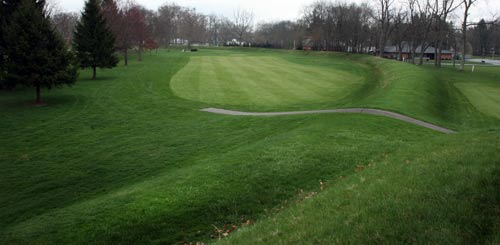Newark Earthworks
The Newark Earthworks are located right inside the city of Newark Ohio. Many of the earthworks have been destroyed with advancing civilization. However, the parts that do remain give a visitor the immensity of scale the walls of earth that were once the center of the Hopewell Civilization about 2000 years ago. These earthen walls represent the largest set of geometric earthen enclosures ever built.

The Octagon Earthworks
The Octagon Earthworks located inside of the Moundbuilders Country Club form a major part of the Newark Earthworks. There are 2 basic parts of the Octagon Earthworks: the 8 sided semi-rectangular set of walls with 8 distinct sides, hence the name Octagon Earthworks. But those expecting to see a perfectly shaped stop-sign construction might be disappointed because the earthen walls are not shaped in such a manner. Instead, the walls are straight lines with gaps of about 20' or so in between. At each gap, on the inside of the perimeter is a rectangular flat topped mound. Each one is 8' high and 75 to 90' feet long and 40 - 60' wide. The purpose of these mounds is not clear.

Like many of the earthworks in Ohio, the Octagon Earthworks has not only a rectangular shaped area, but a smaller circular area. Smaller is a bit of a misnomer. The interior of the circle is about 20 square acres of land that is more than 1050' in diameter. That means you could lay 3 football fields end-to-end inside the circle and still have room left over for the cheerleaders. Other than from an airplane, you can't even see the entire circle from anywhere, only portions of it.

Shown above: Observation mound as seen from inside the circle. Note that the wall of the circle seems to turn into the larger observation mound. On the opposite side of the observation mound, the wall of the circle can be seen coming out of the larger mound.
On the southwestern end of the circle is a large rectangular mound, called the observation mound which is about 8' higher than the adjoining portions of the circle. It is the highest point on the grounds and is 170' long and built across what appeared to be an opening in the circle. On the inside the walls of the circle, the walls seem to turn into the observation mound, and then re-appear on the other, or outside side. This would seem to suggest that at one time the observation mound was not part of the original structure and was added at some time later, closing the original gap.
If you could draw a line from this opening to the middle of the 8-sided rectangle at the other end, that line would line up with where the moon rises every 18.6 years which is the furthest point north where the moon rises. The significance of this alignment will probably never be fully understood, and may simply have been a way of keeping track of time periods longer than the 4 seasons.

View from Observation Mound looking east at a portion of the circular mound.
One point of interest when you walk around the exterior of the great circle earthworks, is how the top of the wall remains level, even though the ground may go up or down, the top of the wall is level.
The Octagon Earthworks has a viewing platform that gives you a pretty good view of much of the site. The entire site can only be accessed when open golfing is not in session. This includes November through March, visitors can access the site on Mondays during daylight hours. From April through October visitors may access the site on Monday mornings, unless the golf club has a special event. Whenever you visit, you must staff off the putting greens, and off the bunkers. Visitors to the earthworks, may not access the country club either.

Hopewell Craftsmanship
In addition to being skilled engineers and builders, the Hopewell Culture also had accomplished artisans. Using copper, mica, obsidian and other raw materials imported from sources 100s of miles away, craftsman fashioned carved stone pipes, ornaments and other objects that have been recovered during some excavations. Some of these items are displayed at the museum in Moundbuilders Park.


